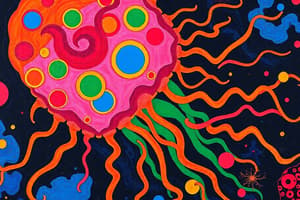Podcast
Questions and Answers
Which characteristic is most useful in differentiating Entamoeba histolytica cysts from Entamoeba coli cysts?
Which characteristic is most useful in differentiating Entamoeba histolytica cysts from Entamoeba coli cysts?
- Number of nuclei within the cyst (correct)
- Size of the cyst
- Presence of chromatoidal bars
- Shape of the trophozoite
Entamoeba hartmanni is considered a pathogenic species of amoeba that causes intestinal disease.
Entamoeba hartmanni is considered a pathogenic species of amoeba that causes intestinal disease.
False (B)
What is the infective stage for all three Entamoeba species listed?
What is the infective stage for all three Entamoeba species listed?
Cyst
Following ingestion of cysts, Entamoeba histolytica trophozoites invade ______.
Following ingestion of cysts, Entamoeba histolytica trophozoites invade ______.
Match each Entamoeba species with a distinguishing characteristic:
Match each Entamoeba species with a distinguishing characteristic:
Flashcards
Entamoeba histolytica
Entamoeba histolytica
Protozoan causing amebiasis with a trophozoite having 1 nucleus.
Amebiasis
Amebiasis
Disease caused by Entamoeba histolytica, affecting intestines & extraintestinal locations.
Entamoeba coli
Entamoeba coli
Non-pathogenic protozoan with a trophozoite having 1 nucleus and up to 8 cyst nuclei.
Trophozoite size of E. histolytica
Trophozoite size of E. histolytica
Signup and view all the flashcards
Diagnostic Stage for E. histolytica
Diagnostic Stage for E. histolytica
Signup and view all the flashcards
Study Notes
Protozoa Species Characteristics
-
Entamoeba histolytica:
- One nucleus in trophozoite stage, 1-4 in cyst stage.
- Infective stage: cyst.
- Shape & appearance: Amorphous, moves with pseudopodia, may contain RBCs.
- Disease: Amebiasis (intestinal & extraintestinal).
- Size (Trophozoite): 8-65 µm (average 12-25 µm)
- Size (Cyst): 12-18 μm.
- Diagnostic stage: Quadrinucleate cyst in feces.
- Life Cycle Notes: Cysts ingested → excyst in intestine → trophozoites invade tissue.
-
Entamoeba coli:
- Up to 8 nuclei in trophozoite stage.
- Infective stage: cyst.
- Shape & appearance: Granular cytoplasm, coarser than E. histolytica.
- Disease: Non-pathogenic.
- Size (Trophozoite): 20-30 um.
- Size (Cyst): 10-33 μm.
- Diagnostic stage: Cysts in feces.
- Life Cycle Notes: Lives in the colon, feeds on bacteria, does not invade tissue.
-
Entamoeba hartmanni:
- Up to 4 nuclei in trophozoite stage.
- Infective stage: cyst.
- Shape & appearance: Smaller than E. histolytica, similar morphology.
- Disease: Non-pathogenic.
- Size (Trophozoite): <10 μm.
- Size (Cyst): <10 μm.
- Diagnostic stage: Cysts in feces.
- Life Cycle Notes: Morphologically similar to E. histolytica but smaller.
-
Entamoeba polecki:
- One nucleus in trophozoite stage.
- Infective stage: cyst.
- Shape & appearance: Variable, may contain chromatoidal bars
- Disease: Mild diarrhea (rare).
- Size (Trophozoite): 10-25 μm.
- Size (Cyst): 9-18 μm.
- Diagnostic stage: Cysts in feces.
- Life Cycle Notes: Found in pigs and monkeys; occasional human infections.
-
Entamoeba gingivalis:
- One nucleus in trophozoite stage.
- Infective stage: cyst.
- Shape & appearance: Found in the oral cavity, no cysts.
- Disease: Non-pathogenic.
- Size (trophozoite): 10-20 μm.
- Size (cyst): N/A.
- Diagnostic stage: Trophozoites in oral scrapings.
- Life Cycle Notes: Transferred via direct contact; associated with gum disease.
-
Endolimax nana:
- Up to 4 nuclei in trophozoite stage.
- Infective stage: cyst.
- Shape & appearance: Small, ovoid, lacks chromatin structure.
- Disease: Non-pathogenic.
- Size (Trophozoite): 6-12 μm.
- Size (Cyst): 5-10 μm.
- Diagnostic stage: Cysts in feces.
- Life Cycle Notes: Commonly found in humans, feeds on bacteria.
-
lodamoeba bütschlii:
- One nucleus in trophozoite stage.
- Infective stage: cyst.
- Shape & appearance: Large glycogen vacuole in cyst.
- Disease: Non-pathogenic.
- Size (Trophozoite): 8-20 μm.
- Size (Cyst): 5-20 μm.
- Diagnostic stage: Cysts in feces.
- Life Cycle Notes: Often found in pigs, can infect humans.
-
Naegleria fowleri:
- One nucleus in trophozoite stage.
- Infective stage: trophozoite.
- Shape & appearance: Flagellated and amoeboid forms, enters via nose.
- Disease: Primary amoebic meningoencephalitis (PAM).
- Size (Trophozoite): 10-25 μm.
- Size (Cyst): N/A.
- Diagnostic stage: Trophozoites in brain tissue.
- Life Cycle Notes: Free-living, found in warm freshwater, invades CNS.
-
Acanthamoeba spp.:
- One nucleus in trophozoite stage.
- Infective stage: cyst & trophozoite.
- Shape & appearance: Spiny pseudopodia, slow-moving, Resembles Acanthamoeba.
- Disease: Granulomatous Amebic Encephalitis (GAE), Keratitis.
- Size (Trophozoite): 15-45 μm.
- Size (Cyst): 12-28 µm.
- Diagnostic stage: Cyst or trophozoite in corneal scrapings/brain tissue.
- Life Cycle Notes: Found in soil, water, contact lens solution.
-
Balamuthia mandrillaris:
- One nucleus in trophozoite stage.
- Infective stage: cyst & trophozoite.
- Shape & appearance: Resembles Acanthamoeba.
- Disease: Granulomatous Amebic Encephalitis (GAE).
- Size (Trophozoite): 12-60 μm.
- Size (Cyst): 10-30 μm.
- Diagnostic stage: Cyst or trophozoite in brain tissue.
- Life Cycle Notes: Rare, misidentified as Acanthamoeba.
Studying That Suits You
Use AI to generate personalized quizzes and flashcards to suit your learning preferences.
Related Documents
Description
Explore the characteristics of protozoa species, including Entamoeba histolytica, Entamoeba coli, and Entamoeba hartmanni. Learn about their infective stages, diagnostic features, and life cycle notes. Understand their roles in causing diseases or existing as non-pathogenic organisms.




